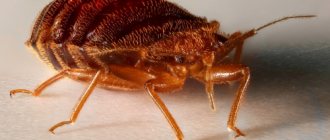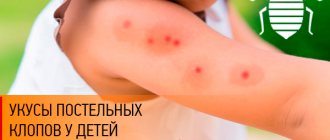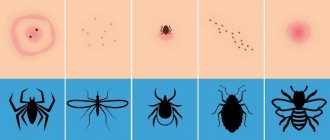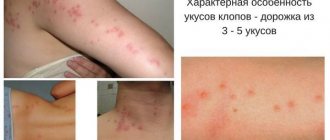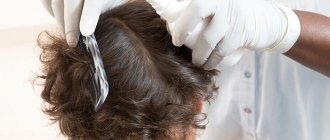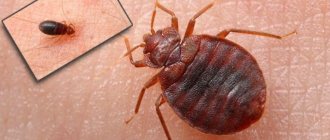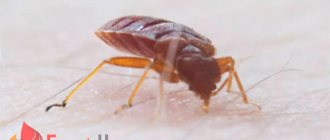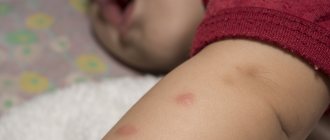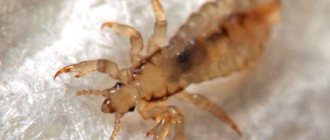- By Vil Malinoshevsky
- About bedbugs
Look at the photo below. These are bed bugs:
Two adults (brown below) and several nymphs of different ages and therefore different sizes are visible here.
This is what bed bugs look like. They are small brown insects, some translucent, yellowish, but all without wings, with a wide, squat body and clearly visible transverse constrictions across the abdomen.
Looking at this photo, it seems that recognizing bed bugs in normal home conditions somewhere in an apartment will be very easy. But our practice shows that this is not at all the case.
It seems that almost every person today can go to the Internet, find a photo of a bedbug, compare with it the insect that he finds in the apartment, and understand whether it is a bedbug or not. But in reality, we are faced with a huge number of situations when people call us, call an exterminator, but cannot say for sure whether they have bedbugs or not. We arrive and usually find that it is bedbugs. Or, on the contrary, it happens that a person panics when he finds an insect on the bed (especially on a child’s bed), he is afraid that bedbugs will bite him, but in reality it turns out that the discovered insect is a beetle grinder, or a skin beetle larva.
On the left is a skin beetle larva, on the right is an adult beetle.
There are also funny cases. For example, once we were sent a photo of a supposed “bug” for identification, but in the photo we found a very exotic pretend beetle. It turned out that he was photographed in New York, but because of his very original appearance, they decided that it was a bedbug.
The same spider beetle from the family of pretenders
In general, even if you have a photo of a bedbug at hand, it is not always possible to find out for sure whether there are bedbugs in a particular apartment. Perhaps this is due to the fact that in the photo the bedbugs are shown in close-up, but in reality they are small and it is difficult to see the details of their structure. Perhaps the smallest larvae are barely visible to the naked eye, and comparing them with a high-quality photo will be problematic.
But in any case, knowing what bed bugs look like, in most cases they can be recognized. Therefore, now we will show good photographs of them and explain what details you need to pay special attention to in order to understand exactly what these parasites are in front of you.
Let's start with the basics...
Adult bed bugs in the photo
Bed bug imagoes, that is, adults, are the most easily recognized. This is how they look on the sofa upholstery:
Please note that their body color is dark brown. The size of such an adult bug is approximately 4-5 mm in length, 3-4 mm in width.
A bug that has just sucked blood has a burgundy-red abdomen, since the covers of its body are translucent and the blood itself is visible through them. The photo below shows such a well-fed parasite:
And here on the left is a bug before blood-sucking, and on the right after saturation:
Feel the difference…
In most individuals, within a day or two after saturation, the blood is digested and only a small black spot of irregular shape is visible on the body:
This spot of semi-digested blood is even better visible in nymphs with their thinner and more transparent body coverings:
Adult bedbugs differ from nymphs in size and darker body color. For example, in this photo there is an adult bug and several nymphs:
Please note: none of the specimens have wings. This is a distinctive feature of bed bugs: due to the specifics of their lifestyle, they have lost their wings, which they do not need, for maximum flattening of the body and the ability to hide in the narrowest crevices. From the wings that the ancestors of these insects had, bed bugs only have small rudiments left on the pronotum:
Another interesting fact is that bed bugs make up an entire family with about 100 species. Of these, Cimex lecturarius is most often found in human housing, but sometimes Cimex hemipterus is also found here. The first is distributed throughout the world, the second - mainly in the tropics. Moreover, Cimex hemipterus has more hairs on its body than Cimex lecturarius.
The photo here shows Cimex lecturarius, the most domestic of bed bugs:
And here is Cimex hemipterus:
And this is what the imago of the species Cimex pipistrelli, which parasitizes bats, looks like:
Here, by the way, he is photographed on the wing of a bat
That is, in real conditions it is almost impossible to determine the type of bed bug with the naked eye.
Moreover, even from representatives of other genera, an ordinary bed bug can only be distinguished under a microscope and with certain knowledge. For example, here in the photo is the swallow bug Oeciacus hirundinis:
Agree, it is also identical in appearance to the indoor Cimex lecturarius.
But distinguishing a female from a male in this species is quite simple. Females have a wider and more rounded body, while males have a small protrusion at the end of the abdomen with a copulatory organ, turned to one side. Externally, it creates the impression of asymmetry.
Here in the photo on the left is a male, on the right is a female bedbug:
And here are two males, only the one on the left is hungrier, and his body is lighter:
In nymphs, even the last instars, there are no visible differences between females and males due to the underdevelopment of the reproductive system.
By the way, photos of nymphs are no less interesting...
General information about the appearance of the insect
As noted above, bed bug (other commonly used names are apartment, linen, sofa, mattress, household, etc.)
is one of the types of bed bugs. It is widespread in different regions of the world, and its habitat coincides with that of humans. This is not surprising, given the peculiarities of the bedbug’s diet, which consists of human or animal blood.
The answer to the question of what an apartment bug looks like should begin by indicating the size of the insect. The length of the body of an adult varies widely - from 3 to 8-9 mm. As a rule, females are noticeably larger than males.
Depending on environmental conditions, quality and quantity of food, the color of the parasite varies from different shades of dull yellow to light and dark brown. The photo below shows a bedbug with a typical insect color.
What do nymphs of different ages look like?
Nymphs are bedbug larvae. Like other insects with incomplete metamorphosis, they are similar in appearance to adult bedbugs, have a similar body structure, lead the same lifestyle and feed on the same food - human blood. Their differences from adult individuals are in size and color, as well as in the underdevelopment of some organ systems, in particular the reproductive one.
This is what a first instar nymph looks like, having just left the egg:
And this is a nymph before the last molt, after which she will enter adulthood:
As we see in the photo, nymphs have yellowish translucent body covers at all stages of their development. Droplets of blood pumped from a person are especially clearly visible through them.
In the video below you can see how the nymph feeds and how, when sucking blood, blood literally flows into her stomach:
After saturation, the nymphs become bright red, looking like running droplets of blood:
The nymphs of the first instar bedbugs are very small; they cannot even always be seen on the bed. But the nymphs of the last instars are already comparable in size to adults.
The photo below shows nymphs of all ages next to an egg and an adult bug:
During its development, the nymph molts 4-5 times, increasing in size after each molt. Within half an hour to an hour after shedding the old body covers, the new cuticle of the larva is very soft and almost white, translucent. Seeing such an individual on a bed or on a sofa, you might even think that such a white bug is a representative of some other species. For example, here is a just-molted “baby”:
It is these nymphs, especially the smallest ones, that people most often do not consider bed bugs and try to find out what kind of insects they are. We came across different cases: once students told us on the phone that these were probably some spiders that had multiplied on the mattress. Another time we showed these larvae to an old grandmother in an infested apartment, and she swore that we, apparently, were not exterminators at all, because we didn’t know what bed bugs looked like, but she knew that they were round and brown...
What other traces do they leave?
Any traces of bedbugs should alert the owners. If you do not get rid of parasites in a timely manner, then within a few months a whole colony of bloodsuckers will form.
Characteristic signs of presence include:
- Bites on the body in the form of a track.
- Sweetish smell in the apartment.
- Black dots on the bed, wallpaper, furniture.
- Chitin shells.
- Clutches with eggs.
- Bloody traces of bedbugs on the sheet.
To ensure the presence of parasites, you need to carefully inspect the mattresses and sleeping areas. Sometimes bloodsuckers hide in baseboards or old furniture; if you turn on the lights at night around 2-4 o'clock in the morning, you can see adult individuals going out hunting.
Insects have a flattened body, about 1 cm in length, antennae, and three pairs of legs. Nymphs are smaller in size and lighter in color.
When they are full, their body takes on a characteristic bloody color. Adult insects are dark in color regardless of food intake.
Several photos of bed bug eggs
Due to their small size, bed bug eggs are difficult to find and see indoors. Moreover, they are white and blend in with the upholstery of the sofa, the color of the wallpaper or bed linen, on which they can be placed.
Enlarged, they look like this:
The larvae have not yet hatched from these eggs.
This photo clearly shows that the eggs have a specific cup-shaped shape. At the top of the egg there is a flat “lid”, which the larva discards when hatching and climbs out.
By the way, under a microscope or with good vision and the naked eye, you can distinguish an egg with an embryo from an empty shell from which the nymph has already hatched.
Here in the photo on the left is the empty shell of the egg from which the nymph hatched, on the right is the egg in which the embryo develops:
The second egg is dull white and opaque because the embryo is tightly packed inside it. This is what eggs with embryos look like:
It can be seen that they are opaque. And in this photo there are close-ups of empty egg shells:
It is clearly visible that they are translucent, and the “hats” are open in the upper part.
Directly on furniture and in various bedbug hiding places, the eggs look like grains of long-grain rice. Interestingly, they stick with the bottom to the surface, and therefore it is impossible to simply brush them off.
As a rule, in an apartment, bedbug eggs are found in clusters on furniture, since females lay them in the quietest suitable places, where they themselves gather in large quantities. Moreover, such accumulations even in photographs look creepy, and one can only guess what an unprepared person who looks at such masonry on his sofa experiences. For example:
Or a cluster like this:
But, as a rule, eggs themselves are not found either in clusters or individually. Usually they are found together with bedbugs, their larvae and all accompanying waste products in those places where bedbugs hide during the day and which are not entirely correctly called nests.
Infection through clothing
Being in a dysfunctional apartment is not enough for bedbugs to appear in things. Parasites do not like light and prefer to be nocturnal. During the day they hide in their shelters and go out hunting only after dark. Therefore, bedbugs can appear in clothes only if a person spends the night in such a place. Such a need may arise during travel, vacation or business trip. Returning home with such “baggage” promises to soon be in the vicinity of an entire population of domestic bugs.
On a note!
Another way of infection by bloodsuckers through things is through parcels. Considering that bedbugs themselves do not live in clothes, this does not prevent them from staying in them for some time. The folds of the product can serve as a good refuge for the parasite.
We cannot exclude the possibility of finding eggs in such places, from which larvae will appear after a certain time. The likelihood of such a situation occurring is especially high when the premises are highly contaminated.
Bed bugs in clothes
Bedbug nests in the photo
Actually, bedbugs do not form organized nests like wasps and especially ants. They simply hide during the day in the most suitable places, and since there are much fewer such places in the room than there are bedbugs themselves, these parasites can accumulate in huge quantities in the most comfortable shelters. In these places there are the bugs themselves, both adults and nymphs of all ages, eggs, remains of the chitinous covers of the larvae, excrement, and in general they look very unpleasant.
For example, here is a typical bedbug nest on a sofa upholstery:
And here the video shows the same accumulation, only on a blanket, which is generally atypical for bedbugs - they prefer to settle on stationary surfaces that are not disturbed by people:
Here is another place for bedbugs to hide, rest and breed, which completely covered one side of the mattress on the bed:
The largest such “nest” that we saw caught the eye of exterminator Kostya in an apartment near Moscow - it was about 80 cm in diameter and was located in the sofa. It is difficult to say how many parasites there were in it, but the sight was, to put it mildly, repulsive.
By the way, this is what a cluster of small larvae looks like right on the mattress:
It was precisely these young individuals that the students we have already mentioned mistook for some strange spiders. But they were definitely sure that these were not bedbugs.
Such hiding places cannot be called nests, because there is no organization or order in them. For example, in the nests of wasps, termites or ants, strict order reigns: the queen lays eggs, the workers look after her, the brood, the nest itself, obtain food, and protect the nest from enemies. All this is not present in bedbug clusters:
- There is no queen that lays eggs alone - all adult females lay them;
- There are no individuals who would maintain order here - everything in such a shelter accumulates spontaneously, complete disorder reigns here;
- The nest is not protected in any way by anyone, and when it is opened, some of the bugs try to run away, the other part hides, hoping that they will not be noticed;
- There is no hierarchy in such a cluster. Bedbugs simply accumulate here, spend daylight hours here, reproduce and die here.
By the way, you have probably already noticed that almost everywhere in such places of accumulation you can see black dots that look like balls. You probably already guessed what it is...
Reasons for appearance
The main reasons for the appearance of soldier bugs on the site include:
- rotten stumps in the garden;
- dried plants;
- piles of dry garbage and leaves;
- a large number of weeds, especially quinoa and wormwood;
- legumes;
- piles of wood;
- alfalfa in your or neighbors' garden;
- growing carrots, cabbage, beets, currants on the site.
Insects especially love alfalfa. To get rid of the larvae, you need to uproot the grass and burn it.
The insects often nest in legumes and alfalfa to combat winter cold.
In some cases, insects may appear in an apartment, more often in a private house. If you have indoor flowers, seedlings or other vegetation, insects will multiply very quickly. There is a tendency that when a soldier appears, other relatives run after him. If there is no food, they die or go to other places.
Bed bug excrement as obvious traces of their presence in the apartment
Yes, yes, this is exactly excrement, in common parlance – “poop”. This is what they look like close up:
And so - in the general photo of the nest:
They are black, in places where they accumulate, they are usually already dry and simply crumble when crushed. When fresh, they smudge and form ink blots that cannot be washed off with water. By the way, they may contain pathogens of dangerous diseases, and accidentally rubbing the contents of such feces into the skin is the only way to become infected with anything from bedbugs.
In the morning, by the way, such stains from them can be found on the body if such feces are smeared on the skin at night.
Very often, without even knowing that bedbugs live in the room, people find such excrement in the dust when cleaning and do not even think about what it is. So, know that these are waste products of bed bugs:
By the way, they are one of the most noticeable and first visible signs of the presence of bedbugs in a room. After bedbug bites on the body, of course...
Conclusion
Any suspicion of a bedbug requires a thorough inspection. To carry it out, you need to know what the parasite looks like and how it differs from other insects. If it is confirmed that bedbugs live in an apartment or house, you must immediately contact specialists to carry out insecticidal treatment or carry out similar protective measures yourself.
What do bed bug bites look like?
The consequences of bedbug bites on the body are usually the first detectable sign of the presence of these parasites in the apartment. Due to the fact that bedbugs hide well, they almost never catch your eye by accident, but if a person has a strong reaction to the bites, then the next morning after the bites he discovers the following redness on his body:
Or these:
Sometimes they are even found on the face:
As a rule, in the early stages of infection of an apartment, these swellings are few in number and sometimes do not attract attention at all - the person thinks that he was bitten by a mosquito or just some pimple popped up. And only when such bites begin to appear regularly and their number begins to constantly grow, does the bitten person begin to suspect the constant presence of some bloodsuckers in the apartment.
The worst photographs of bedbug bites, as a rule, do not reflect the typical picture. For example, like this:
It happens extremely rarely when a person spends one night in a heavily contaminated room (for example, in a hotel in some outback). If a person has such a pronounced reaction to bedbug bites, then in his own home he will begin to feel them when there are 2-3 of them every night, and, accordingly, will take action before the parasites multiply in quantities capable of biting so strongly. Exceptions are rare - for example, if neighbors poisoned bedbugs and all these brethren rushed to run away to neighboring apartments, an invasion and severe bites may occur in one of these apartments.
By the way, many people do not feel bedbug bites at all, even when there are many such bites. For example, one of our volunteers checked his reaction to bites - there was no such reaction. Watch the video:
It is dangerous if there are people living behind your wall who also do not have such a reaction, and they have bedbugs. These neighbors simply won’t know that they have parasites living in their house, they will safely feed them without feeling it, the bedbugs will multiply, crawl into the neighbors’ premises and gradually get into yours.
On a note
According to statistics, the majority of such people who are not sensitive to bedbug bites are from 65 to 75%. This is the main reason that bedbugs still thrive near humans: most people simply do not suspect that they are feeding these parasites, and they happily reproduce next to their hosts.
There is no obvious relationship between a person’s gender or age and their sensitivity to bites. It happens that even small children or women with thin and seemingly sensitive skin do not have any bumps left on their bodies from bites. And it happens that tough grown men suffer greatly from these bumps, they develop severe symptoms, even generalized ones. It all depends on the individual reaction of the body to the components of bedbug saliva.
This is, for example, what a bitten man looks like with a very acute reaction to substances secreted by bedbugs:
This difference in sensitivity, by the way, often leads to the misconception that bedbugs indoors do not bite all people and somehow select them based on their blood type, age or gender. We dispelled this myth in a separate video:
The main feature of bed bug bites is that they form characteristic chains of 3-4 cones. For example, the following “paths” are visible in the photo:
And these:
Such “paths” of bites are left by adult bedbugs, each of which sucks blood from several wounds in one person in one night. The parasite pierces the skin, sucks blood, then removes its proboscis, moves 2-3 cm forward, makes a new puncture, sucks again - and so on 3-4 times. Its entire course turns out to be well marked with bumps from bites.
Young nymphs, as a rule, do not leave such “paths”, since the blood from one bite is enough for the insect to be completely saturated. And the spots at the site of their bites sometimes do not swell. Here, for example, small feeding nymphs are shown, and below is a spot at the site of the bite:
Therefore, in heavily infested apartments, bitten people have both individual bumps and bites connected in “chains” on their bodies.
As a rule, such bites go away on their own without special treatment. If they itch too much, you can lubricate them with a special ointment after Hector bites - it quickly soothes the itching, relieves redness and prevents secondary infection of the bite site with bacterial infections. If you don’t have Hector ointment on hand, you can lubricate the bites with Menovazin or other pain-relieving ointment. When the effect of the ointment is completed, the bites themselves will go away, or at least will not itch.
And, by the way, most other parasitic insects that can live next to a person in his home also do not leave such “paths”. This makes it quite easy to distinguish bedbugs from other bloodsuckers and simply harmful roommates in the apartment.
Folk remedies
They are used for scaring, not killing. Strong-smelling substances (for example, vinegar, valerian, wormwood, wild rosemary) are not liked by bedbugs. If there is an aromatic plant in the room, there is a chance that bedbugs will look for another place to nest.
A product such as vinegar is well suited for treating furniture - it does not leave marks on the fabric. It can also be poured into cracks and hard-to-reach places - vinegar is not dangerous to humans, and the smell quickly disappears.
It is important to remember that folk remedies do not help get rid of bedbugs, but can prevent them from spreading throughout the apartment.
We distinguish bedbugs, fleas, ticks and lice from photos
It is enough to see bedbugs and other synanthropic insects next to each other once, so that later, when you encounter them in an apartment, you will never make a mistake with identification.
For example, here the photo shows a bug next to two red cockroaches:
On the left is an adult bedbug, in the center is a Prussian nymph, on the right is an adult red cockroach. It can be seen that even small red cockroaches are larger than an adult bug. Cockroaches also have a slimmer, elongated body, and adults have wings, which bedbugs do not have. But the most reliable difference is the presence of cerci at the end of the abdomen in cockroaches - two outgrowths similar to short antennae. Bedbugs don't have them.
And here is a bedbug next to two black cockroaches, also a nymph (middle) and an adult female (right):
In principle, it can be confused with a nymph due to the similarity in size and color.
In any case, all cockroaches run much faster than bedbugs, and the big ones run so fast that sometimes you can’t even swat them. Bed bugs crawl much slower and it is not difficult to crush them.
And here in the photo on the left is a bedbug nymph, and on the right is an adult cat flea:
They are similar in size, but the bug is lighter in color, and its body seems to be flattened on top (although in nymphs this is not as noticeable as in adults). Fleas are darker, and their body, on the contrary, is laterally compressed.
But the main difference between these parasites is that fleas jump, while bedbugs cannot do this. Moreover, fleas jump so quickly that the jump is not noticeable at all: it seems that the parasite was just here, and now it has simply disappeared. If this happened, then it was a flea.
On a note
By the way, fleas can also sometimes bite several times during one feeding and leave chains of bites, but this happens very rarely.
People often ask us how to distinguish a bedbug from a tick. It is important to understand here that there are practically no cases when they really need to be distinguished for two reasons:
- There is some external resemblance between bed bugs and ixodid ticks (the same ones that can carry encephalitis and tick-borne borreliosis), but these parasites are not found nearby - ixodid ticks do not live in human homes, and bed bugs do not live in meadows and forests, where Ixodids are found. Simply put, you cannot find ixodid ticks in an apartment - they do not survive here. As an exception, it may happen that one of the people or a dog brings such a tick home and the parasite falls here. Below we will show how to understand that it is a tick and not a bug;
- So-called dust mites can constantly live in apartments, feeding on skin particles that are exfoliated from people. But it is, in principle, impossible to confuse them with bed bugs, since they cannot be seen with the naked eye: the body length of adult individuals is 0.3-0.4 mm, and due to the translucency of the integument, they are practically invisible in the dust and in the pile of carpets, where they usually live . Simply put, if you see any arthropod indoors, it is definitely not a dust mite.
This is what dust mites in a home carpet look like under a microscope:
They do not bite people and only harm people by excreting substances that are strong allergens in their excrement. It is believed that more than half of the cases of allergic rhinitis and bronchial asthma of unknown etiology in people are associated with an allergy to dust mite secretions. Moreover, ticks often settle in pillows and mattresses, excreting excrement in close proximity to the face of a sleeping person.
On a note
Dust mites are much more widespread than bed bugs - they are found in varying numbers in approximately 95% of households around the world.
That is, we found out: the only thing that can be confused with bedbugs is an ixodid tick that was accidentally brought from a walk. This is what these parasites look like next to each other:
On the left is a bug, on the right is a tick
All you have to do to tell them apart is count the legs. Bed bugs have 6 (3 pairs), ticks have 8 (4 pairs). If it turns out to be a tick, you can either kill it (which, by the way, is difficult - they have a very strong body), or throw it outside - there are no relatives in the room, since ixodid ticks do not reproduce here.
Finally, small bedbug nymphs can be confused with lice. Look at the photo - here on the left is a bedbug nymph, on the right is a head louse:
Their sizes are approximately comparable, but the louse is more slender and elongated in length. In addition, lice are found either on a person’s hair or on his underwear; if we are talking about pubic lice, then on the hair in the groin. It is almost impossible to find lice under a mattress, on a baseboard, or on furniture - due to their low mobility and inability to move on a smooth surface, they die here very quickly. Bedbugs, on the other hand, are not found in people's hair or underwear, since they are uncomfortable crawling there.
But an even more reliable difference between bedbugs and lice is that lice bite a person around the clock, since each individual must feed once every 3-4 hours. Bedbugs normally bite only at night.
Finally, if you come across an insect in your apartment that looks like a bedbug, only with wings, it could be an outdoor stink bug. Here's a comparison:
On the left is a bedbug, in the center is a green stink bug, on the right is a berry stink bug. The proportions in size are approximately preserved.
Such shield bugs do not bite people, but they stink strongly when frightened. It is better to catch such a find with a handkerchief and throw it out the window.
It is clear that there are other insects with which bedbugs, and especially their nymphs, can be confused. Ants, small spiders, grinder beetles—whatever clients send us in photographs so that we can help them figure out what exactly they found in their home. But such errors are rare and occur rarely.
Habitats
The favorite habitats of bed bugs are secluded, warm and quiet places. These include sofas and beds. When settling there, insects are guided by only one principle - to be close to the victim (human). In addition, parasites do not have a big appetite: only one meal a week is enough for them to satisfy their hunger. If it wants to get enough of blood, the pest will leave its hiding place and calmly get to the sleeping person.
